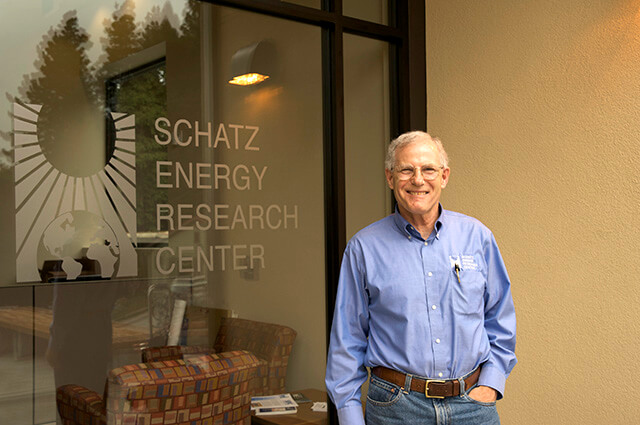California Redwood Coast-Humboldt County Airport and U.S. Coast Guard Air Station’s 100% renewable energy, front-of-the-meter, multi-customer microgrid is fully operational in California.
The new microgrid was developed through a partnership between the County of Humboldt, Pacific Gas and Electric Co. (PG&E), Schatz Energy Research Center at Cal Poly Humboldt, Schweitzer Engineering Labs, Redwood Coast Energy Authority, Tesla Inc., The Energy Authority, and TRC.
The Redwood Coast Airport Microgrid (RCAM) features a 2.2 MW solar photovoltaic array that is DC-coupled to a 2 MW (9 MWh) battery energy storage system, comprised of three Tesla Megapacks. It also includes a microgrid control system, with protection and isolation devices that interfaces directly with PG&E’s distribution control center.
The microgrid serves multiple functions and is managed in collaboration between project partners. The Schatz Energy Research Center is the prime contractor and technology integrator, leading the design, testing and deployment of the clean energy microgrid.
“The Redwood Coast Airport Microgrid has ushered in a new and exciting era for the electric grid in California,” says Peter Lehman, founding director of the Schatz Center and project lead. “With its successful deployment and the development of new microgrid agreements and tariffs, RCAM has become a role model and beacon to communities across the state who are striving to green their energy supply and bolster their resilience in the face of climate change.”
Redwood Coast Energy Authority (RCEA), the Community Choice Aggregator for the Humboldt Bay area, owns the two solar arrays and the battery energy storage system.
During standard blue-sky operations, RCAM generates clean energy for the North Coast and participates in the California Independent System Operator (CAISO) wholesale energy markets, including the day-ahead, real-time and ancillary services markets.
By storing solar energy during the day and releasing it onto the grid as needed in the evening and during peak demand, RCAM enables greater utilization of solar, supports grid reliability and creates an economic model for future microgrids.
“RCEA’s goal is to provide our customers with 100 percent carbon-free electricity by 2025, and 100 percent local carbon-free electricity by 2030. This project is a major milestone for our clean energy and resilience efforts,” states Matthew Marshall, executive director of RCEA, which works closely with schools, fire departments, tribes and other local agencies to support community resilience across the North Coast.
PG&E owns, operates and maintains the microgrid circuit and controls the microgrid during “islanded” operation. In the event of a broader grid outage, the clean-energy microgrid provides indefinite power for the 19 connected customers by disconnecting or “islanding” from the broader grid when needed and becoming an independent, PG&E-operated grid segment. This ensures that airport flight service and rescue operations continue without interruption.
“The Redwood Coast Airport Microgrid represents the culmination of many years of research, innovation and collaboration by the world’s leading microgrid experts,” comments Jason Glickman, PG&E’s executive vice president of engineering, planning and strategy. “Thanks to this team’s smart work, microgrids now play a key role in PG&E’s ongoing efforts to harden our electrical system and enhance local grid resilience throughout Northern and Central California. We know how much our customers and communities need reliable energy, and this system not only increases local reliability, it also serves as the foundation for a replicable and scalable model for widely deploying multi-customer microgrids across PG&E’s service area. This gives communities a new tool in securing their resilience and clean energy goals.”
The regional California Redwood Coast-Humboldt County Airport (ACV) is in McKinleyville, Calif., and serves the greater North Coast community with over 50,000 flights per year, including commercial airline, private and emergency medical flights. Adjacent to the airport, the U.S. Coast Guard Air Station Humboldt Bay provides search and rescue for 250 miles of rural coastline, from the Mendocino-Sonoma County line to the California-Oregon border.
Roads into Humboldt County are frequently closed by fires and mudslides, making air services a critical factor in regional emergency response.
“The California Redwood Coast-Humboldt County Airport (ACV) is a lifeline to our community every day by keeping Humboldt County connected to the world alongside our partners at United Airlines, Avelo Airlines, American Airlines, REACH/Cal-Ore Life Flights, U.S. Coast Guard-Sector Humboldt Bay and many others,” says Cody Roggatz, Humboldt County’s director of aviation. “RCAM ensures that we can continue to keep that lifeline open through energy resilience, no matter what happens to the power grid.”
Research and development for the microgrid was supported through California’s Electric Program Investment Charge (EPIC) – a statewide, customer-funded program that enables PG&E, other California investor-owned utilities and the California Energy Commission to execute emerging technology demonstration and deployment projects that address important grid needs. EPIC plays a role in helping drive the innovation needed to meet California’s policy and clean energy goals while also ensuring the safe, reliable and affordable operation of the grid.
The collaboration between RCAM project partners has informed technical and policy innovations including the development of the Community Microgrid Enablement Tariff and PG&E’s Community Microgrid Enablement Program (CMEP).
To date, PG&E has engaged with more than three dozen communities and customers to explore potential financial and infrastructure support options for developing microgrids and resilience solutions through the CMEP.
Additionally, PG&E, along with Southern California Edison and San Diego Gas and Electric, are developing the Microgrid Incentive Program (MIP), leveraging a $200 million statewide fund dedicated to the development of clean energy microgrids supporting the critical needs of vulnerable populations and disadvantaged communities. The companies anticipate launching this program in late 2022.
Together, the MIP and PG&E’s CMEP provide comprehensive financial support for both the distributed energy resources and other costs necessary to develop and energize a microgrid, as well as the distribution upgrades necessary to enable the safe islanding of the microgrid.
The Schatz Center is partnering with several tribes in Northern California to support their clean energy, resilience and climate response efforts. Cal Poly Humboldt also recently began design of a renewable energy microgrid to support campus resilience through clean generation. This microgrid will be part of the university’s sustainability framework, and will enable students in engineering, environmental sciences and other programs to gain hands-on experience with innovative climate-friendly technologies.




